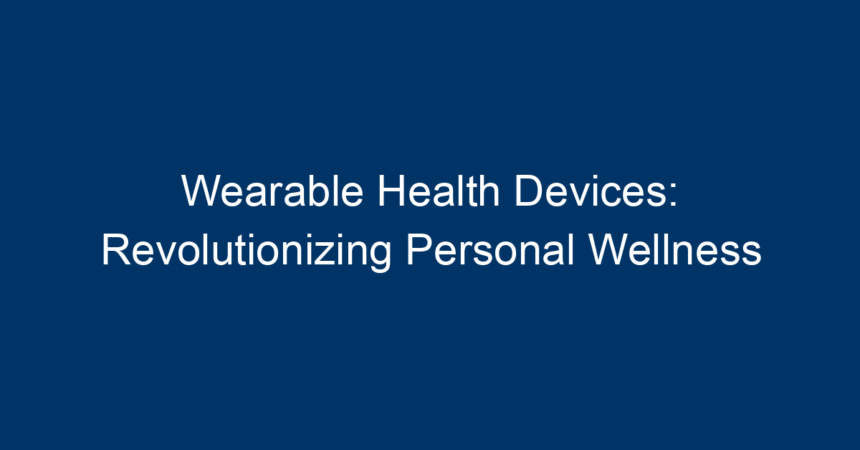Introduction
In an era where technology meets health, wearable health devices have emerged as pivotal players in personal wellness. From smartwatches that track heart rates to fitness bands that monitor daily activity, these devices offer countless benefits that extend beyond mere tracking. They empower individuals to take charge of their health, providing real-time insights and fostering a deeper understanding of one’s physical condition. As we delve into the world of wearable health devices, we will explore their functionalities, benefits, and the future they hold in transforming personal wellness.
What Are Wearable Health Devices?
Wearable health devices are electronic gadgets designed to be worn on the body. These devices utilize sensors, software, and sometimes mobile applications to monitor health metrics and physical activities. Common types of wearable health devices include:
- Smartwatches: Beyond telling time, smartwatches offer heart rate monitoring, GPS tracking, and notifications for calls and messages.
- Fitness Trackers: These focus more on physical activity, tracking steps taken, calories burned, and sleep quality.
- Smart Clothing: These garments come equipped with sensors that monitor body metrics such as temperature, heart rate, and muscle activity.
- Medical Devices: Specially designed wearables can monitor chronic health conditions, such as diabetes management apps and heart health monitors.
The Rise of Wearable Health Devices
The surge in wearable health devices can be attributed to several factors:
1. Increased Health Consciousness
In recent years, there has been a marked shift towards proactive health management. People are more aware than ever of their health and fitness, and wearable health devices provide the tools necessary to monitor and improve their lifestyles.
2. Advancements in Technology
With rapid advancements in technology, wearable devices have become more sophisticated, accurate, and user-friendly. Features that were once considered high-end are now standard, allowing for a broader uptake among consumers.
3. Connectivity and Integration
Wearable health devices effortlessly connect to smartphones and other digital platforms. This connectivity allows users to access their data anytime and provides a comprehensive view of their health trends over time. Integration with apps further enhances this experience, facilitating goal setting and health monitoring.
Key Features of Wearable Health Devices
Wearable health devices come equipped with a variety of features that cater to users’ diverse needs:
1. Heart Rate Monitoring
Most wearable health devices now include heart rate monitors that track your heart rate in real-time. This feature allows users to manage stress, monitor their exertion during workouts, and even detect irregular heartbeats.
2. Activity Tracking
Whether it’s counting steps, tracking workouts, or measuring distance traveled, activity tracking is a staple feature. Users can set daily goals, encouraging them to stay active.
3. Sleep Quality Monitoring
Sleep is crucial for overall health, and many devices can track sleep patterns, providing insights into sleep quality and duration. This feature often includes smart alarms that wake users at optimal times in their sleep cycle.
4. Customizable Alerts and Notifications
Wearable devices offer customizable notifications related to health goals, reminders for hydration, and alerts for prolonged inactivity. This ability helps users maintain focus on their wellness journey.
5. GPS and Navigation
For outdoor enthusiasts, GPS functionality is invaluable. Whether you’re running, hiking, or biking, wearables with built-in GPS help you track routes and distances accurately.
Benefits of Using Wearable Health Devices
The advantages of incorporating wearable health devices into daily life are numerous.
1. Enhanced Awareness of Health Metrics
These devices promote self-awareness by providing real-time data about vital signs and physical activity. Users can track fluctuations and trends, empowering them to make informed health choices.
2. Motivation and Accountability
Many individuals find that wearable health devices promote motivation. By visualizing their progress through achieved goals and daily statistics, users can hold themselves accountable for their health journey.
3. Early Detection of Health Issues
Wearable health devices can serve as early warning systems for potential health issues. For example, abnormal heart rate patterns or irregular sleep cycles can prompt users to seek medical advice promptly.
4. Improved Fitness and Wellness Goals
With the capability to set and track wellness goals, users are more inclined to adopt healthy habits. This objective tracking can lead to significant lifestyle changes over time.
Challenges and Considerations
While the benefits of wearable health devices are undeniable, it’s crucial to consider some challenges:
1. Data Privacy and Security
As with any technology, data breaches pose a significant risk. Users must be cautious about sharing personal health information and choose devices that prioritize security.
2. Accuracy of Data
Not all wearables measure health metrics with the same level of accuracy. Users should research and choose reputable brands known for reliable data.
3. Device Dependency
While these devices can enhance wellness, over-reliance on technology for health monitoring might lead to heightened anxiety or health concerns.
The Future of Wearable Health Devices
The horizon for wearable health devices looks promising. Emerging trends indicate:
1. Integration with Telehealth
With the telehealth sector growing, wearables will likely play a critical role in remote patient monitoring. This integration can provide healthcare professionals with valuable data for better patient outcomes.
2. Enhanced AI Capabilities
The integration of artificial intelligence can further improve the personalization of health insights. Predictive analytics based on user data can help forecast health risks and suggest preventative measures.
3. Customization and Adaptability
Future wearable devices may allow for tailored experiences based on individual health profiles, enhancing user engagement and satisfaction.
Conclusion
Wearable health devices are more than just trends; they are essential tools in the journey of personal wellness. As technology advances, these devices will continue to evolve, enhancing their capabilities and fostering a more health-conscious society. By understanding the features, benefits, and future potential of these devices, individuals can harness the power of technology to take charge of their health and wellness.
Actionable Insights
- Start Small: If you’re new to wearable health devices, consider starting with a basic fitness tracker and gradually explore more advanced options.
- Do Your Research: Investigate and select a device that suits your specific needs. Read user reviews and compare features to find the best fit for you.
- Embrace the Data: Use the insights from your wearable health device to set achievable health goals, and don’t hesitate to share this data with your health care provider.
- Prioritize Security: Ensure your chosen device has robust privacy settings and understand the policies regarding data handling.
- Stay Informed: Keep an eye on emerging trends in wearable health technology to ensure you’re utilizing the best tools available for your wellness journey.
By embracing wearable health devices, you are not just investing in technology; you are investing in your future well-being.




